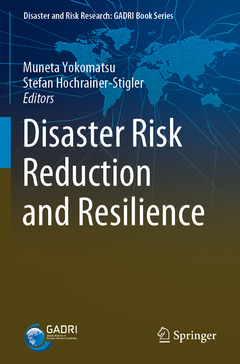Description
Disaster Risk Reduction and Resilience, 1st ed. 2020
Disaster and Risk Research: GADRI Book Series
Coordinators: Yokomatsu Muneta, Hochrainer-Stigler Stefan
Language: English
Subjects for Disaster Risk Reduction and Resilience:
Publication date: 07-2021
236 p. · 15.5x23.5 cm · Paperback
Publication date: 07-2020
Support: Print on demand
Description
/li>Contents
/li>Biography
/li>Comment
/li>
This book provides insight on how disaster risk management can increase the resilience of society to various natural hazards. The multi-dimensionality of resilience and the various different perspectives in regards to disaster risk reduction are taken explicitly into account by providing studies and approaches on different scales and ranging from natural science based methods to social science frameworks. For all chapters, special emphasis is placed on implementation aspects and specifically in regards to the targets and priorities for action laid out in the Sendai Framework for Disaster Risk Reduction. The chapters provide also a starting point for interested readers on specific issues of resilience and therefore include extensive reference material and important future directions for research.
Purpose of volume and its place within the GADRI series of volumes
1. Introduction
Section I: Resilience from Natural Hazards
2. Resilience from Flooding and related hazards
3. Resilience from Volcano and Landslide related hazards
4. Earthquake hazard prone regions global scale
5. Resilience from compound hazards (Natech)
Section II: Resilience within the Built and Social Environments
6. Disaster risk and household’s dynamic asset-formation behavior: Jump control model of household
7. Achieving resilience from viewpoint of social psychology
8. Community Centered Model Approach for Disaster Risk Reduction
9. Augmented/Virtual reality application in disaster preparedness training for society resilience
10. ISET Resilience model
11. Resilience Quantification: Approaches and Applications
Section III: Case studies
12. Community level
13. Fiscal resilience and building back better: A global analysis for disaster risk reduction strategies
14. Drought in Austria
15. Seismic Screening of Large Water Pipelines for the Enhancement of Water Supply Systems — A Case Study of Taiwan16. Insurance
17. Electricity network
Section IV: Conclusion
18. Summary closure:
Where we are, what has been achieved, what is needed…
Focuses on disaster risk reduction from a multidisciplinary resilience perspective
Includes discussions of how diverse topics are connected with goals identified by the Sendai Framework 2015–2030
Addresses resilience to various natural hazards including flood, wind, earthquake, volcano, landslide, and Natech types




